Visible-Light CDMA Communications Using Inverted Spread Sequences
Abstract
:1. Introduction
2. Optical CDMA with MUI Cancellation
2.1. Optical CDMA System and MPSC
2.2. Generalized MPSC
- First, set up a generator vector , where GF() and no two elements and () are equal. For example, we can choose for .
- A group coefficient ( GF()) is selected for each group. No two group coefficients are to be equal. We can choose for .
- Set up constant vectors () over GF(). The vectors have length . All elements in a single vector are identical, and no two vectors are the same. We can choose for .
- Then, the codewords in the code over GF() are generated by the following equation:for and . Multiplication and addition in Equation (2) are the operations over GF . The codewords in the th group are .
- Finally, the codewords in are transformed into binary codewords , which constitute a GMPSC. Every element in GF() which appears in a vector is transformed into the binary -tuple of weight one, and no two tuples are the same. For example, the zero element in GF(4) can be transformed into ‘1000′, into ‘0100′, into ’0010′, and into ’0001′.
2.3. Conventional EWO Scheme
2.4. Conventional Shalaby’s Scheme
2.5. Conventional Liu’s Scheme
3. MUI Cancellation Schemes with Inverted MPSC
3.1. Inverted MPSC
3.2. EWO Scheme with Inverted MPSC
3.3. Shalaby’s Scheme with Inverted MPSC
3.4. Modified Liu’s Scheme with Inverted MPSC
4. Average Light Intensity and Normalized Fluctuation
5. Bit Error Rate Performance
5.1. System Model
5.2. Bit Error Rate Performance
6. Discussion
7. Conclusions
Author Contributions
Funding
Acknowledgments
Conflicts of Interest
References
- Matheus, L.E.M.; Vieira, A.B.; Vieira, L.F.M.; Vieira, M.A.M.; Gnawali, O. Visible light communication: Concepts, ap-plications and challenges. IEEE Commun. Surv. Tutor. 2019, 21, 3204–3237. [Google Scholar] [CrossRef]
- Tsai, C.-L.; Xu, Z.-F. Line-of-sight visible light communications with InGaN-based resonant cavity LEDs. IEEE Photon. Technol. Lett. 2013, 25, 1793–1796. [Google Scholar] [CrossRef]
- Khalid, A.M.; Cossu, G.; Corsini, R.; Choudhury, P.; Ciaramella, E. 1-Gb/s Transmission Over a Phosphorescent White LED by Using Rate-Adaptive Discrete Multitone Modulation. IEEE Photon. J. 2012, 4, 1465–1473. [Google Scholar] [CrossRef] [Green Version]
- Gancarz, J.; Elgala, H.; Little, T. Impact of lighting requirements on VLC systems. IEEE Commun. Mag. 2013, 51, 34–41. [Google Scholar] [CrossRef]
- Jovicic, A.; Li, J.; Richardson, T. Visible light communication: Opportunities, challenges and the path to market. IEEE Commun. Mag. 2013, 51, 26–32. [Google Scholar] [CrossRef]
- Lee, K.; Park, H.; Barry, J.R. Indoor Channel Characteristics for Visible Light Communications. IEEE Commun. Lett. 2011, 15, 217–219. [Google Scholar] [CrossRef]
- Grubor, J.; Randel, S.; Langer, K.-D.; Walewski, J.W. Broadband information broadcasting using LED-based interior light-ing. IEEE J. Lightwave Tech. 2008, 26, 3883–3892. [Google Scholar] [CrossRef] [Green Version]
- Grobe, L.; Paraskevopoulos, A.; Hilt, J.; Schulz, D.; Lassak, F.; Hartlieb, F.; Kottke, C.; Jungnickel, V.; Langer, K.-D. High-speed visible light communication systems. IEEE Commun. Mag. 2013, 51, 60–66. [Google Scholar] [CrossRef]
- Khan, L.U. Visible light communication: Applications, architecture, standardization and research challenges. Digit. Commun. Netw. 2017, 3, 78–88. [Google Scholar] [CrossRef] [Green Version]
- Memedi, A.; Dressler, F. Vehicular Visible Light Communications: A Survey. IEEE Commun. Surv. Tutor. 2020, 23, 161–181. [Google Scholar] [CrossRef]
- Beguni, C.; Căilean, A.-M.; Avătămăniței, S.-A.; Dimian, M. Analysis and Experimental Investigation of the Light Dimming Effect on Automotive Visible Light Communications Performances. Sensors 2021, 21, 4446. [Google Scholar] [CrossRef] [PubMed]
- Yang, G.C.; Kwong, W.C. Prime Codes with Applications to CDMA Optical and Wireless Networks; Artech House: Norwood, MA, USA, 2002. [Google Scholar]
- Shiraz, H.G.; Karbassian, M.M. Optical CDMA Networks: Principles, Analysis and Applications; John Wiley & Sons: Chichester, UK, 2012; pp. 29–114. [Google Scholar]
- Chung, F.R.K.; Salehi, J.A.; Wei, V.K. Optical orthogonal codes: Design, analysis and applications. IEEE Trans. Inf. Theory 1989, 35, 595–604. [Google Scholar] [CrossRef]
- Shaar, A.; Davies, P. Prime sequences: Quasi-optimal sequences for OR channel code division multiplexing. Electron. Lett. 1983, 19, 888–890. [Google Scholar] [CrossRef]
- Kwong, W.; Perrier, P.; Prucnal, P. Performance comparison of asynchronous and synchronous code-division multiple-access techniques for fiber-optic local area networks. IEEE Trans. Commun. 1991, 39, 1625–1634. [Google Scholar] [CrossRef]
- Matsushima, T.K.; Teramachi, Y. Generalized MPSC and its performance in synchronous optical CDMA systems. In Proceedings of the International Symposium on Information Theory and its Applications (ISITA), Seoul, Korea, 3–5 October 2006. [Google Scholar]
- Matsushima, T.K.; Nagao, T.; Ochiai, N.; Teramachi, Y. Generalization of modified prime sequence codes and its properties. IEICE Trans. Fundam. 2008, 91, 559–573. [Google Scholar]
- Ochiai, N.; Kushibiki, S.; Matsushima, T.K.; Teramachi, Y. Performance analysis of synchronous optical CDMA systems with EWO signaling. IEICE Trans. Fundam. 2003, 86, 37–48, Translates in Electron. Commun. Jpn. Part III Fundam. Electron. Sci. 2004, 87, 37–48. [Google Scholar] [CrossRef]
- Shalaby, H.; Sourour, E. Co-channel interference cancellation in optical synchronous CDMA communication systems. In Proceedings of the IEEE International Symposium on Spread Spectrum Techniques and Applications, Oulu, Finland, 4–6 July 1994. [Google Scholar] [CrossRef]
- Liu, M.-Y.; Tsao, H.-W. Cochannel interference cancellation via employing a reference correlator for synchronous optical CDMA systems. Microw. Opt. Technol. Lett. 2000, 25, 390–392. [Google Scholar] [CrossRef]
- Habuchi, H.; Ono, F. Optical Code Shift Keying with Modified Prime Sequences; Technical Report for Institute of Electronics, Information and Communication Engineers: Tokyo, Japan, 2003; pp. 49–54. [Google Scholar]
- Tanaka, S.; Usami, S. Consideration on Multiplexing Code Shift Keying on Optical CDMA System. IEEJ Trans. Electron. Inf. Syst. 2010, 130, 2174–2175. [Google Scholar] [CrossRef]
- Matsushima, T.K.; Kakuyama, M.; Murata, Y.; Teramachi, Y.; Yamasaki, S. A Study on Multi-User Interference Cancellers for Synchronous Optical CDMA Systems—Decision Distance and Bit Error Rate. IEICE Trans. Fundam. Electron. Commun. Comput. Sci. 2017, 100, 2135–2145. [Google Scholar] [CrossRef]
- Sugiyama, H.; Haruyama, S.; Nakagawa, M. Experimental investigation of modulation method for visible-light communica-tions. IEICE Trans. Commun. 2006, 89, 3393–3400. [Google Scholar] [CrossRef]
- Xu, F.; Khalighi, M.-A.; Bourennane, S. Impact of different noise sources on the performance of PIN- and APD-based FSO receivers. In Proceedings of the 11th International Conference on Telecommunications, Graz, Austria, 15–17 June 2011; pp. 211–218. [Google Scholar]
- Hui, R. Photodetectors. In Introduction to Fiber-Optic Communications, 1st ed.; Academic Press; Elsevier: Cambridge, MA, USA; London, UK, 2020; pp. 209–297. [Google Scholar]
- Matsushima, T.K.; Sasaki, S.; Kakuyama, M.; Yamasaki, S.; Murata, Y. A visible-light communication system using optical CDMA with inverted MPSC. In Proceedings of the International Workshop on Signal Design and Its Applications in Communications (IWSDA), Tokyo, Japan, 20–24 October 2013; pp. 52–55. [Google Scholar]
- Kawamoto, R.; Nakamura, S.; Matsushima, T.K.; Miyazaki, S.; Omura, K.; Yamasaki, S. Development of Visible-Light CDM Experimental System Using MPSC and MUI Canceller; Technical Report for Institute of Electronics, Information and Communication Engineers: Tokyo, Japan, October 2017; pp. 1–6. [Google Scholar]
- Rajagopal, S.; Roberts, R.D.; Lim, S.-K. IEEE 802.15.7 visible light communication: Modulation schemes and dimming support. IEEE Commun. Mag. 2012, 50, 72–82. [Google Scholar] [CrossRef]


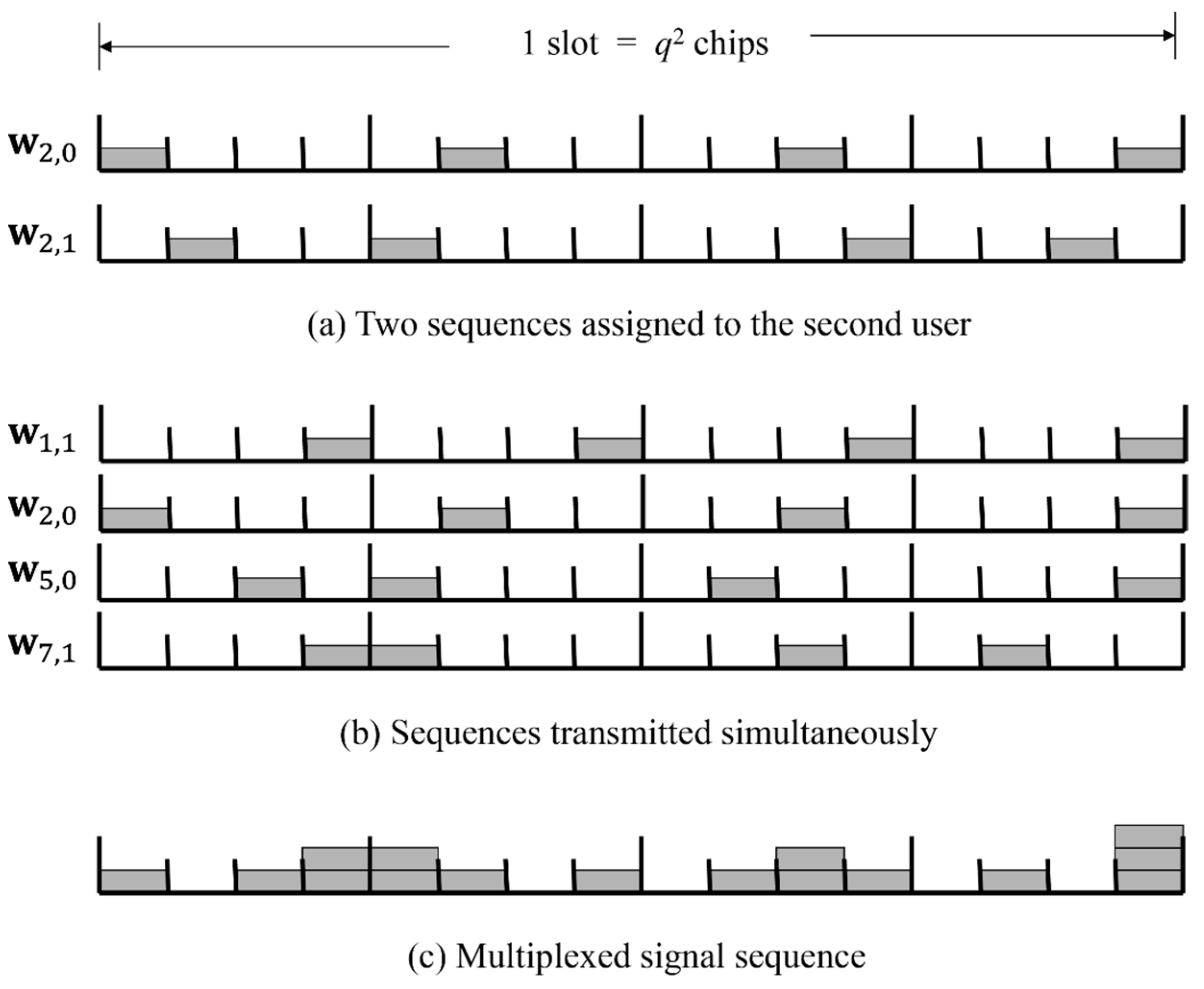
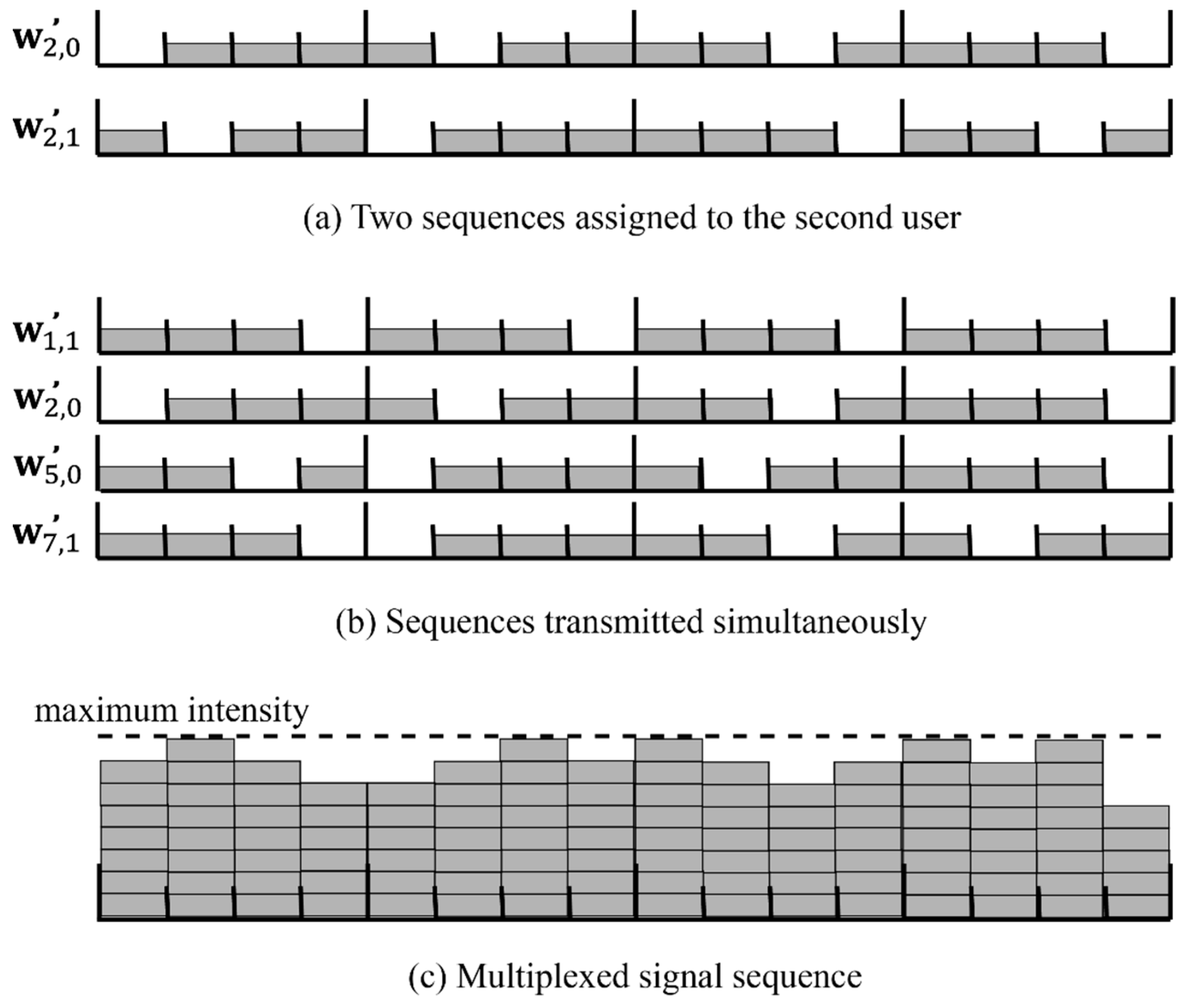
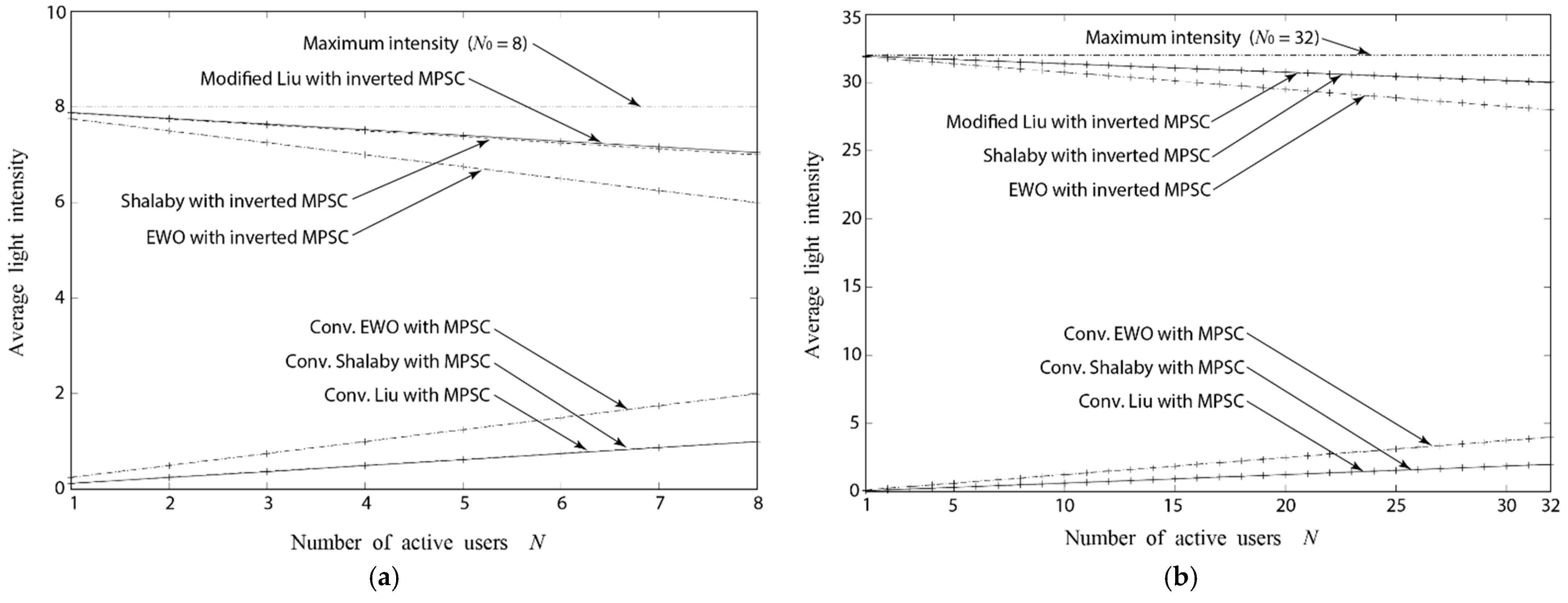
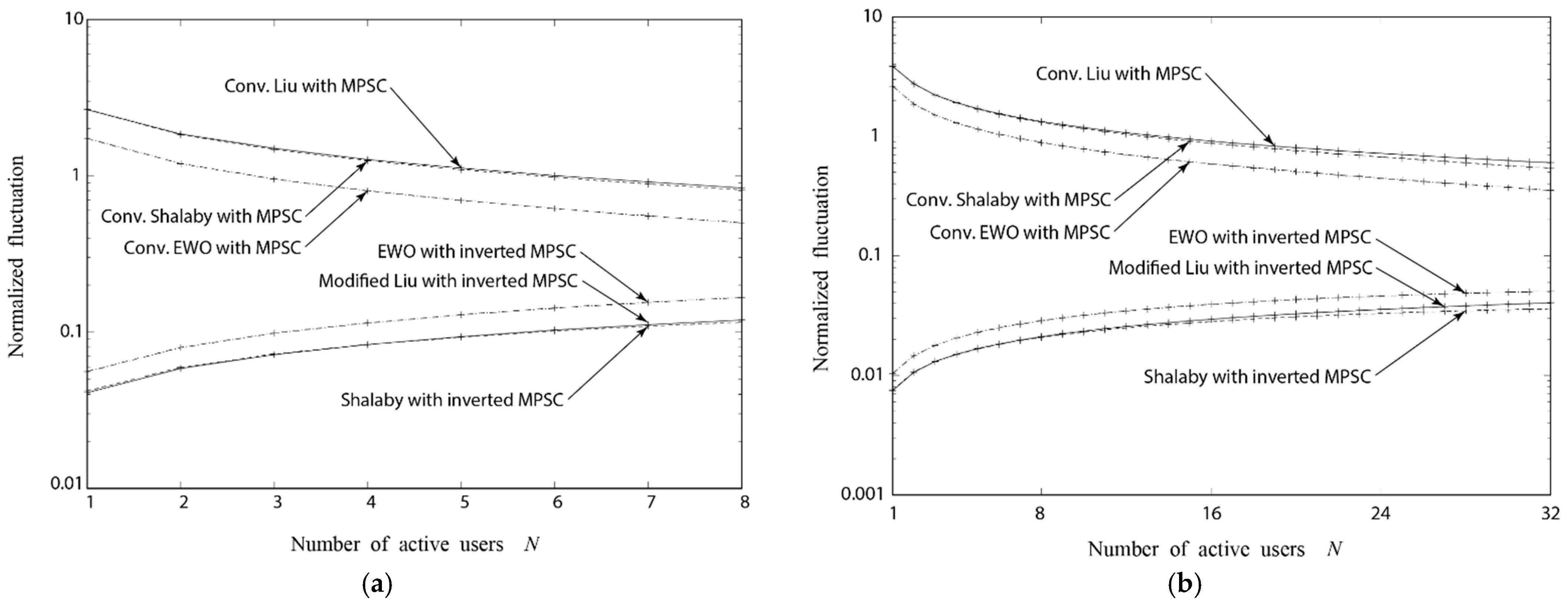

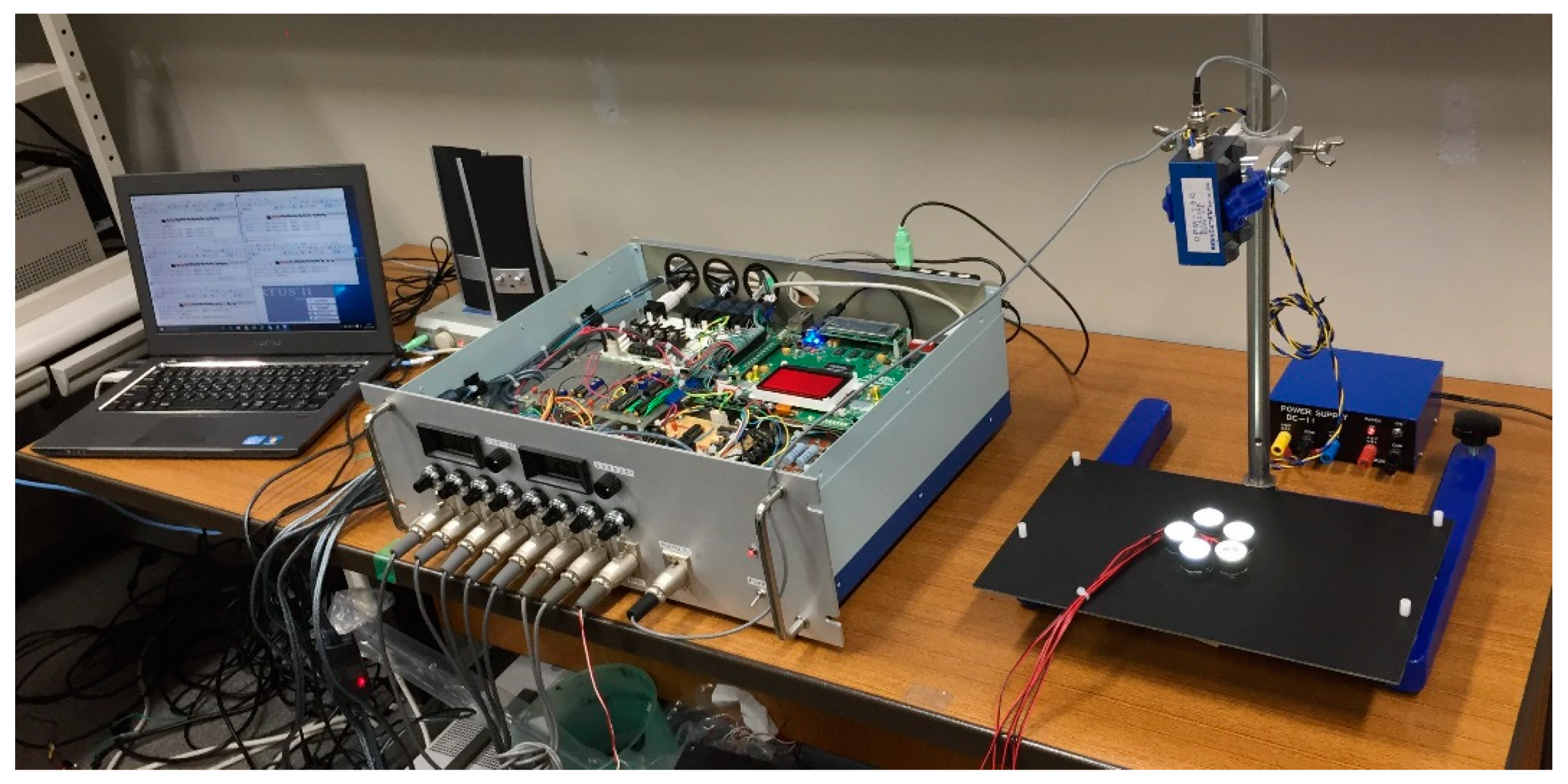
| Group | Generalized MPSC | ||
|---|---|---|---|
| Codeword Assignment | ||||
|---|---|---|---|---|
| Group | Codeword | EWO | Shalaby | Liu |
| Code | MPSC | Inverted MPSC | ||||
|---|---|---|---|---|---|---|
| MUI Cancellation Scheme | EWO | Shalaby | Liu | EWO | Shalaby | Modified Liu |
| Codeword Assignment | ||||
|---|---|---|---|---|
| Group | Codeword | EWO | Shalaby | Modified Liu |
| Code | Scheme | Code | Scheme | ||
|---|---|---|---|---|---|
| MPSC | EWO | Inverted MPSC | EWO | ||
| Shalaby | Shalaby | ||||
| Liu | Modified Liu |
| Parameter | Parameter | ||||
|---|---|---|---|---|---|
| Chip duration | 10 (ns) | Noise-equivalent bandwidth | 50 (MHz) | ||
| Background light power | 45 (dBm) | Receiver noise temperature | 320 (K) | ||
| Received load resistance | Quantum efficiency | η | 0.6 | ||
| Wavelength | 660 (nm) | Modulation extinction ratio | 100 | ||
| Dark current | 0.1 (nA) | ||||
Publisher’s Note: MDPI stays neutral with regard to jurisdictional claims in published maps and institutional affiliations. |
© 2022 by the authors. Licensee MDPI, Basel, Switzerland. This article is an open access article distributed under the terms and conditions of the Creative Commons Attribution (CC BY) license (https://creativecommons.org/licenses/by/4.0/).
Share and Cite
Matsushima, T.K.; Yamasaki, S.; Ono, K.; Tanaka, H. Visible-Light CDMA Communications Using Inverted Spread Sequences. Electronics 2022, 11, 1823. https://doi.org/10.3390/electronics11121823
Matsushima TK, Yamasaki S, Ono K, Tanaka H. Visible-Light CDMA Communications Using Inverted Spread Sequences. Electronics. 2022; 11(12):1823. https://doi.org/10.3390/electronics11121823
Chicago/Turabian StyleMatsushima, Tomoko K., Shoichiro Yamasaki, Kyohei Ono, and Hirokazu Tanaka. 2022. "Visible-Light CDMA Communications Using Inverted Spread Sequences" Electronics 11, no. 12: 1823. https://doi.org/10.3390/electronics11121823






